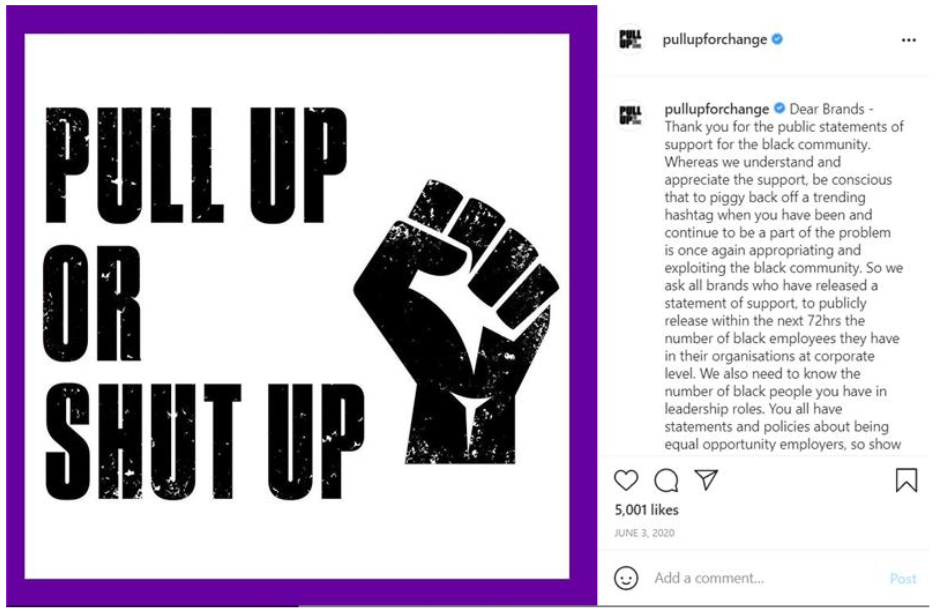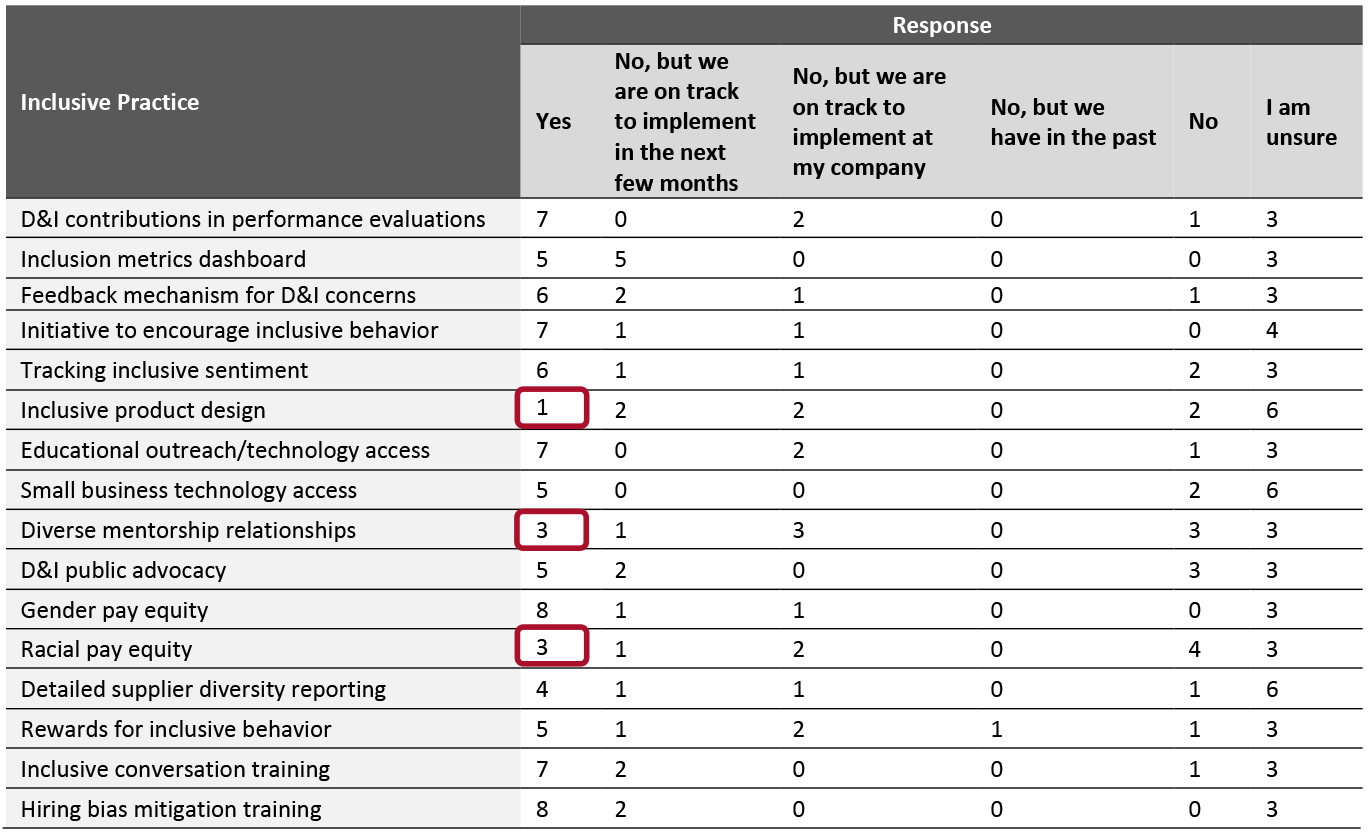
DIpil Das
What’s the Story?
Coresight Research has identified inclusivity as one of the key trends to watch in 2021. Inclusivity—providing equal access for people who might otherwise be excluded or marginalized—has accelerated in the light of the racial justice movement in the US helping to inspire a global conversation on diversity and representation. It is not just a trend but a movement that is impacting the entire retail industry. Companies are focusing on their corporate strategies to improve diversity of race, gender and disabilities across their organization, influencing internal teams, products and the supply chain. In this report, we explore the forces that are driving inclusivity in corporate structures and policies—from consumer pressure to initiatives by stock exchanges—the inclusive corporate strategies that brands and retailers operating in the US are implementing and the importance and benefits of an inclusive corporate culture.Why It Matters
Inclusivity is a thread that touches every part of an organization, both internally and externally. It is guided by an organization’s strategic goals and mission. Conversations around diversity and inclusion are leading organizations to assess their internal teams and goals. By enacting inclusivity internally and throughout the supply chain, brands and retailers become more socially responsible and can tap growth opportunities in serving underrepresented individuals.Inclusive Corporate Strategies in US Retail: A Deep Dive
Driving Forces Behind Inclusivity in Corporate Structures and Policies Consumer Pressure The social environment of 2020 has had the biggest impact on corporate policies, propelling conversations around inclusivity to the forefront both on social media and through corporate channels. Last year, there was an outpouring on social media related to the Black Lives Matter movement, with consumers demanding that big beauty companies reveal their corporate diversity metrics, as it was believed that they were promoting messages on social media that did not match their internal organizational structures. [caption id="attachment_130757" align="aligncenter" width="725"] The “Pull Up or Shut Up” campaign started a social media movement of consumers demanding that companies disclose the diversity of their corporate structures
The “Pull Up or Shut Up” campaign started a social media movement of consumers demanding that companies disclose the diversity of their corporate structures Source: Pullupforchange Instagram account [/caption] The pressure from consumers for brands and retailers to increase transparency around inclusivity and diversity is prompting organizations to make changes in internal team structures, hiring policies and procedures. The Nasdaq’s New Diversity Requirements and Alliance for Global Inclusion In December 2020, the Nasdaq Stock Market filed a proposal with the Securities and Exchange Commission to adopt new rules regarding board diversity and disclosure for Nasdaq-listed companies. Under the proposal, Nasdaq companies would have to have at least two diverse directors (at least one woman and at least one member of an underrepresented community) or explain why it has failed to do so. Companies would be required to disclose board diversity on an annual basis in a prescribed tabular format. The Nasdaq Stock Market is an American stock exchange based in New York City; it is ranked second among stock exchanges by market capitalization of shares traded, behind the New York Stock Exchange. On April 29, 2021, the Nasdaq announced a new industry coalition, Alliance for Global Inclusion, which has developed shared diversity and inclusion metrics. The alliance includes four technology companies: Dell, Intel, NTT Data Corp and Snap. In May 2021, the Alliance published its first semi-annual inclusion index—findings from a global survey of 13 major companies, launched by Intel in 2020, to determine the status of diversity and inclusion progress. The stated goal of the index is to “learn about current D&I [diversity and inclusion] practices and identify opportunities to potentially improve D&I outcomes across industries. A public index increases transparency, which builds trust, drives collective action, and scales impact.” The index provides details on each of the companies’ diversity workforce representation in terms of gender, race and ethnicity. It also provides information on diversity and inclusive practices, covering training, mentorship, pay, suppliers, product design, and inclusion tracking and measurement. The index shows that three key areas of opportunity are inclusive product design, diverse mentorship and racial pay equity, with the fewest companies reporting that they have such practices (see Figure 1). The diversity practices that are most established are hiring bias mitigation training, inclusive conversation training and educational outreach—underscoring that diversity and inclusion is an industrywide movement.
Figure 1. Inclusion Index: Whether Companies Have, or Perform, Select Inclusive Practices (Number of Companies) [caption id="attachment_130758" align="aligncenter" width="724"]
 Base: 13 public companies (11 technology companies, one energy company and one industrials company), surveyed from May 2020
Base: 13 public companies (11 technology companies, one energy company and one industrials company), surveyed from May 2020 Source: Alliance for Global Inclusion [/caption] Brands and Retailers’ Inclusive Corporate Strategies We are seeing brands and retailers take action to implement inclusive corporate strategies, with two primary areas of focus: diversity in the workforce through inclusive hiring initiatives and diversity in brand portfolios and supplier bases. We discuss inclusivity in recruitment and the supply chain below. Recruitment Many major brands and retailers are updating their corporate strategies to incorporate inclusivity goals, with specific targets for increasing diversity among its workforce, including and at senior levels. In Figure 2, we present examples of recent developments in this space by notable brands and retailers operating in the US.
Figure 2. Recent Inclusive Hiring Initiatives by Selected Brands and Retailers Operating in the US [wpdatatable id=1157 table_view=regular]
Source: Company reports
- Inclusively: Connecting Candidates with Disabilities to Companies and Careers
Figure 3. Recent Initiatives by Selected Brands and Retailers Operating in the US To Update Product and Supplier Representation [wpdatatable id=1158 table_view=regular]
Source: Company reports The Importance and Benefits of a Culture of Inclusivity Diversity in Leadership On April 23, 2021, Deborah Weinswig, CEO and Founder of Coresight Research, moderated a panel at Blue Yonder’s ICON conference. She was joined by Willa Blasingame, Vice President of Americas Supply Planning and Logistics at food company McCormick & Company, and Katie Low Anderson, CFO of Guess?, Inc., to discuss how brands and retailers can leverage diversity and inclusion to optimize their supply chains. The panel highlighted the importance of diversity in leadership and the role of mentors in inclusive corporate structures:
- Diverse executive teams—There are very few women in supply chain executive roles, which Blasingame attributes to transportation and logistics being traditionally male-dominated roles. She added that there is a major rebranding opportunity as many people do not understand “what supply chain is,” its many components, technological aspects and multiple functions and players. Blasingame emphasized that having diverse leaders is extremely important for employees to not only see representation but to see action behind words. According to Blasingame, the CEO of McCormick & Company met with the organization to highlight that diversity initiatives were important to him, which she described as an important signal to employees.
- Mentors—Mentors help employees to navigate company politics and to learn more quickly. Anderson stressed that making personal connections is very important to Guess?, Inc. globally; there are a lot of women at Guess and the company makes mentoring a priority. Blasingame explained that she has previously addressed the Society of Women Engineers at the University of Maryland Baltimore County, where she shared her experiences and knowledge about the Science, Technology, Engineering and Mathematics (STEM) careers available to them. Blasingame spoke about what it takes to be successful—not just focusing on academics, but on important soft skills such as the ability to work with different people from diverse backgrounds. She explained that learning to navigate your way to the decision-making table takes time and patience, and she stressed the importance of sensitivity and cultural awareness. On the panel, she emphasized that the percentage of women coming out of engineering is still very low, so it can be isolating as a woman in this field; mentoring is therefore especially important for women engineers.
What We Think
Inclusion is an industrywide movement that is being driven both by consumer demand and new policies that may put in place diversity requirements for public companies. While the Securities and Exchange Commission has not yet finalized its position, it is clear that the backdrop to inclusion is changing, and companies need to update their corporate strategies accordingly.- Major retailers and brands have focused on hiring initiatives that improve workforce and leadership representation. We expect this to be an industry standard measurement as consumers and stakeholders will be expecting companies to report updates on these metrics.
- Diversity and inclusion initiatives also impact suppliers and product and brand portfolios, providing opportunity for brands and retailers to attract a new customer base through underrepresented brands.
- Executives from selected companies report that diverse executive teams, mentorship and retention initiatives help to support inclusive cultures. We are hearing that employees feel empowered when they hear from leaders like them in positions of power; mentorship is beneficial for everyone (and especially those that may be underrepresented); and retention is especially important for diversity. Brands and retailers should focus on these areas when developing and implementing inclusive corporate strategies.